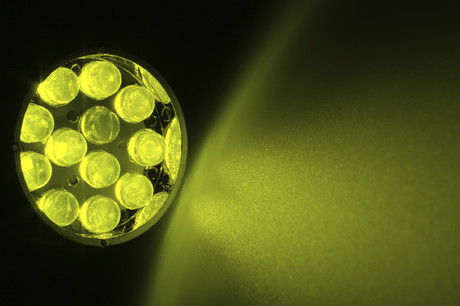Supplementing Wi-Fi with LEDs

University of Edinburgh researchers have alleviated potential fears about using light-emitting diodes (LEDs) for wireless communication, revealing that transmitting digital data via LEDs does not make LED light dimmer or change its colour.
Although it has long been known that LEDs can be ‘piggybacked’ to transmit data to and from mobiles, tablets, sensors and other devices, questions have surrounded the ability to do this without affecting the LEDs’ core capabilities. Preserving the quality of lighting is, in particular, a vital consideration as it can have a major effect on the wellbeing of people in both their homes and their workplaces. Dr Wasiu Popoola, who led the research, said these concerns have held back the more widespread adoption of light fidelity, or Li-Fi, which uses household LEDs to enable data transfer.
Focusing on LEDs producing ‘warm white’ and ‘cool white’ light, Dr Popoola and his team looked at two different data transmission techniques: on-off keying, where the LED works like Morse code, switching on and off extremely rapidly and imperceptibly to human eyes; and continuous signalling, where imperceptible changes in light intensity are used to achieve the same goal.
Neither technique was found to significantly reduce the lightbulbs’ brightness or their life expectancy, or to cause any significant change in the colour of the light. Both techniques also produced only a negligible change in the heat generated by the LEDs — a key consideration, as any temperature increase would indicate the LED using more electricity to produce light, making it less energy-efficient and less carbon-friendly.
The research findings help eliminate key hurdles to using LEDs to satisfy the increasing global thirst for wireless communications, with Dr Popoola noting, “Our ever more connected world will need more bandwidth than the overcrowded radiofrequency part of the spectrum can provide.
“Plugging a key knowledge gap, our results are very encouraging for the future of light-based communications that could help realise the full economic and social potential of a wireless future,” Dr Popoola said. “It’s vital that LED manufacturers know what impact the incorporation of data transmission capabilities would have on their products. Our research shows that there’s no dark side to using LED lights to supplement Wi-Fi.”
3D semiconductor chip alignment boosts performance
Researchers have developed an ultra-precise method to align 3D semiconductor chips using lasers...
Researchers achieve 8 W output from optical parametric oscillator
Researchers have demonstrated a total output power of 8 W from a high-power mid-infrared cadmium...
"Dualtronic" chip for integrated electronics and photonics
Cornell researchers have developed a dual-sided chip known as a "dualtronic" chip that...






